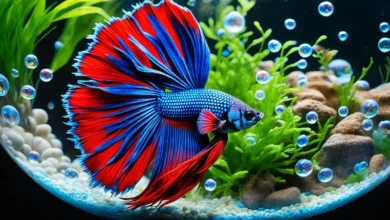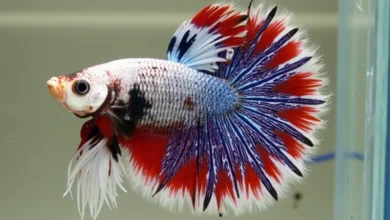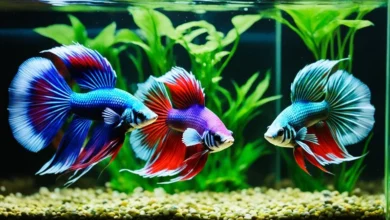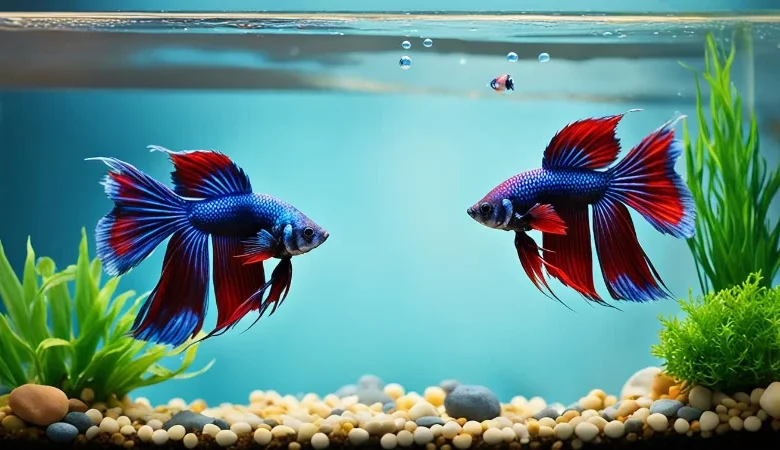
Do you have a colorful Siamese fighting fish, better known as a betta fish? Wondering when they’re set to breed? Recognizing the subtle signs that show your betta is ready to mate is crucial. We’ll look into these cues, guiding you to know when your betta fish is ready to breed.
Many people love betta fish for their vibrant looks and spunky behavior. Once your betta is of breeding age, they start to show changes. These can be seen in how they act and look. Knowing these ready to breed signs helps make sure they mate and have healthy babies.
Understanding Betta Fish Breeding
Betta fish, also known as Siamese fighting fish, are famous for their bright colors and interesting behaviors. To breed them successfully, it’s key to know when they are ready. You can tell it’s time when you see certain traits in both males and females.
Physical Signs of Breeding Readiness
Male bettas build bubble nests as a sign they want to breed. This is a nest, made of bubbles, on the water surface. It’s a key clue the male is prepared.
Female bettas might develop an egg spot when they are ready to spawn. A swollen belly and vertical stripes are other signs. Males show off bright colors and spread their fins wide to attract a mate.
Watching for these changes can help fish owners know the best time to breed their bettas. This understanding makes it easier to set up successful breeding environments.
Signs That the Betta Male is Ready to Breed
Male betta fish show clear signs when they are ready to breed. They start by making a bubble nest on the water’s surface. This nest keeps their eggs safe. The male carefully makes it out of air bubbles.
They also get brighter colors and their fins stand out more. This is to attract a female. Flared fins show off their beauty and strength.
Male bettas act more aggressively when ready to breed. They might fight their reflection or other fish in the tank. This behavior helps them show they’re the strongest and should mate.
Signs That the Female Betta is Ready to Breed
Just like male betta fish, females also have special signs they’re ready to breed. Knowing these cues is key to a successful breeding process. This prepares us to spot when a female is at the right stage for mating.
1. Visible Egg Spot
A major sign that a female is ready to spawn is the egg spot. This is a tiny, white, or pink dot near her anal fin. It shows her eggs are almost ready to be released.
2. Vertical Stripes
When a female betta fish gets ready to breed, she might show vertical stripes. These stripes can get darker or more visible. It’s a sign she’s open to mating.
3. Swollen Belly
Another clear sign of readiness in a female is her swollen belly. This happens as her eggs grow inside. It lets us know she’s nearly ready to spawn.
4. Receptive Behavior
Beyond physical changes, females may act differently when they want to breed. They might swim near the male more, stay calm, and seem more open to his advances. These behaviors indicate their breeding readiness too.
Behavioral Signs of Breeding Readiness
Besides looking for physical clues, there are also signs in a betta fish’s behavior that it’s ready to breed. Watching for these behavioral signs of breeding readiness can help breeders know when it’s the right time.
One main sign is that the betta will start moving around more. It will swim a lot and pay more attention to other fish in the tank. This increased action shows they’re ready to mate.
They also show interest in their possible partner more. Male bettas might puff out their fins and show off their bright colors. On the other hand, females might seem more open, swimming near the male and looking at his efforts.
By keeping an eye on these behavioral signs of breeding readiness, breeders can improve their chances of successful mating. Understanding what the fish are saying through their actions is key to good breeding outcomes.
Pre-Breeding Rituals
Before spawning, betta fish go through detailed pre-breeding rituals. These include dances with their fins and circling each other. Watching these rituals helps fish keepers know the right time to mate them.
Betta fish’s pre-breeding rituals show off their instincts and social life. Males puff their fins to show they’re in charge. Females might react by showing patterns or acting friendly. These signs tell fish keepers when the bettas are ready to mate.
Rituals before breeding do more than show if bettas like each other. They also help the fish time their breeding right. Fish keepers learn when their bettas are ready to lay eggs by watching these careful steps.
Environmental Factors for Breeding
Getting the right environment for betta breeding is key. You need to set the perfect water conditions, and tank setup, and keep the temperature and light just right. This helps bettas want to breed and improves the chances of success.
Ideal Water Conditions
For the breeder tank, the water must be clean, dechlorinated, and at the perfect pH, temperature, and hardness. Water levels must stay consistent. This helps the breeding and keeps the bettas and their fry healthy.
Optimal Tank Setup
Your breeding tank should have room and dividers to separate male and female bettas at first. Adding hiding spots like plants and decorations makes a comfy space for them. A mature biofilter also promotes a natural setting.
Temperature and Lighting
The tank’s temperature and light greatly affect breeding behavior. Keep the water between 75°F and 82°F and the light on for 12 to 14 hours daily. These conditions are ideal for breeding success.
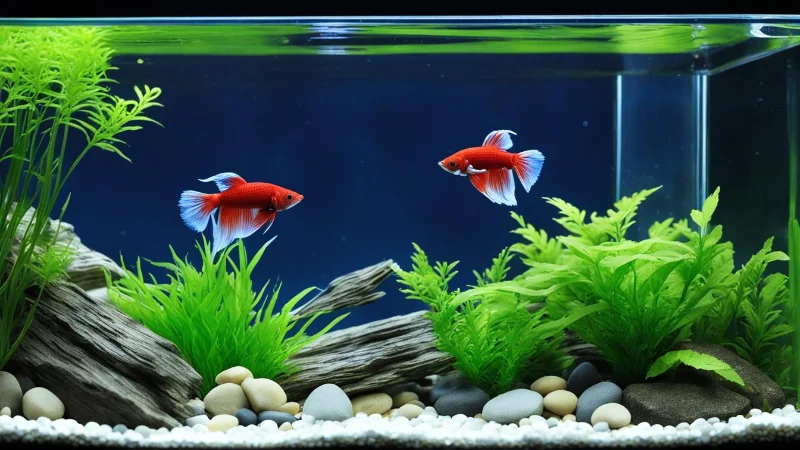
Diet and Nutrition for Breeding Bettas
For betta fish ready to breed, a balanced, protein-rich diet is key. Foods like bloodworms, brine shrimp, and daphnia are excellent choices. They aid in developing the bettas’ reproductive organs. This leads to the production of healthy eggs and sperm.
Protein-Rich Foods
Variety is important in the betta fish diet for successful breeding. Besides the mentioned protein sources, adding freeze-dried or frozen foods is beneficial. These foods are also protein-rich. They give the bettas what they need for their reproductive system to work well.
Feeding Schedule
Consistent feeding times are key for breeding bettas. Offer protein-rich foods to them regularly. This step ensures they get the nutrition needed for breeding. Feed bettas several times a day. Give them small amounts they can eat in minutes.
Pairing Betta Fish for Breeding
Choosing the right betta fish is key to breeding success. Pick a male and female that are ready to breed, similar in size and personality. It’s crucial to be cautious during their first meeting because bettas are often territorial and aggressive. Keep a close eye on how they get along. This is vital for them to mate and have babies.
Choosing the Right Pair
When looking to breed bettas, choose those that show they’re ready. The male should build a bubble nest and have bright colors and fins. The female must have certain markings showing she’s ready to lay eggs. Making sure they match in size and mood lowers the chance of fights and helps breeding succeed.
Introduction Process
Introducing betta fish for breeding requires planning. Start by putting a see-through wall between them. This lets them get to know each other without fighting. Watch for signs they’re okay with each other, like swimming peacefully. Then, you can take the wall out for them to mate.
Monitoring Compatibility
Always keep an eye on the bettas to see how they’re doing. Watch how they act around each other. Look for any signs of trouble, like fighting or ignoring each other. If they don’t get along, be ready to split them up.
Breeding Tank Setup
Setting up the perfect breeding tank is key to breeding your betta fish successfully. Think about the tank’s size, dividers, what’s on the bottom, and the kind of plants. Making sure the water is just right is also very important.
Tank Size and Dividers
For the breeding tank setup, the tank’s size matters. A 10-gallon tank or larger is best for a breeding pair. Dividers keep the male and female bettas safe from each other at first since bettas can fight a lot. This helps them get used to each other without getting hurt.
Substrate and Plants
The substrate and plants are vital in the tank. Choose soft gravel or sand for the bottom; it helps the male build his bubble nest. Adding live plants is great. They give the fish places to hide and feel comfortable, making them more likely to breed.
Maintaining Water Quality
Optimal water quality is a must for betta breeding. Keep the water at the right temperature, pH, and ammonia levels. Doing regular water changes and using a mature, cycled filter are important steps. They keep the water clean and safe for the fish and their babies.
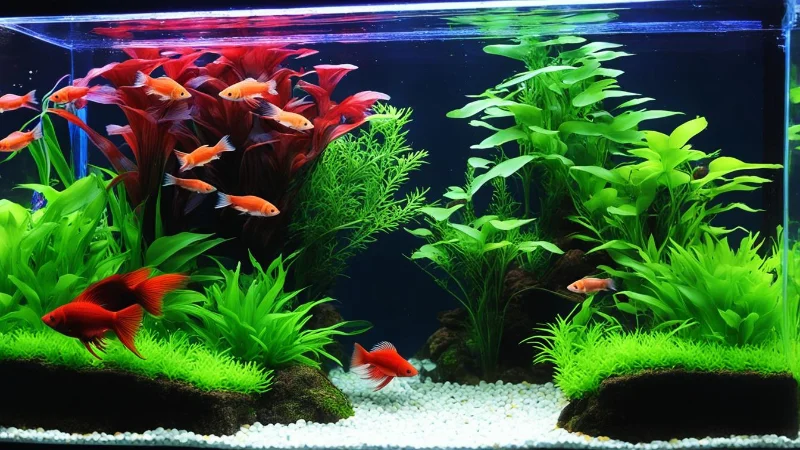
Breeding Process
The breeding process for betta fish includes a detailed courtship and spawning phase. Male and female bettas will show off and check each other out. They go through rituals to make sure they are ready to mate. The male builds a bubble nest on the water and the female places her eggs in it.
Courtship and Spawning
The courtship and spawning phase are interesting to watch. The male does things like puffing up, swimming in circles, and chasing the female. This shows he is ready to mate and wants to impress her. The female responds with calm movements. When they both feel right, the male makes a nest, and the female lays her eggs inside for him to fertilize.
Post-Spawning Care
After the eggs are laid, the male betta looks after them. He makes sure they’re safe and in good condition. Once they hatch, he protects the young fish, known as fry, looking after them until they’re old enough to be by themselves. The female betta isn’t as involved at this stage, often kept apart to avoid any harm to the babies.
Male Betta’s Role
The male betta’s role in the breeding process is key. He builds the nest where the eggs are kept safe. During mating, he shows his best colors and acts tough to impress the female. After the eggs are laid, he watches over them, making sure they’ll be okay on their own.
Female Betta’s Role
The female betta’s role in breeding is just as important, but she’s more laid back. She shows the male she’s interested in having babies by her behavior. Once ready to spawn, she lays her eggs in the bubble nest for the male to fertilize. Then, the male looks after the eggs and fry, and the female rests and recuperates.
Post-Breeding Care
After your betta fish have successfully spawned, taking care of them is very important. Good post-breeding care ensures the health of the breeding pair and their fry. This part of the process is vital for raising strong and healthy betta fish.
Separating the Pair
After breeding, male and female bettas should be separated quickly. This prevents fights and harm. The male might get too protective, attacking the female. Or he could even eat the eggs. Keep the fish safe by moving the female to a different tank or using a divider.
Caring for Fry
Looking after the betta fry is a key step. They need a well-cycled tank to grow well. Good water quality is also a must. This means the right temperature, pH levels, and low ammonia.
Feeding Fry
Feeding the fry is important for their health. Start with protein-rich foods like infusoria and micro-worms. As the fry grows, so do their food needs. Aquarists need to change their diet as the fry develops. Make sure they get all the nutrients they need.
Fry Growth Stages
Knowing the stages the fry goes through helps in caring for them. They change a lot from hatching to becoming adults. This includes watching how they grow and when to adjust their food. Carefully watching the fry’s growth is essential for their well-being.
Common Breeding Challenges
Betta fish breeding is very rewarding, yet it has its challenges. These obstacles are normal and can be dealt with. Overcoming them is key to having successful spawns and raising healthy fry.
Aggression Issues
Managing aggression is a main hurdle in betta fish breeding. It occurs between the breeding pair and within it. Males are often territorial and can be aggressive towards females. It’s important to introduce them carefully and watch over them closely to avoid this problem.
Infertility Problems
Infertility issues are a common hurdle in breeding bettas. Many factors can cause this, like poor health or nutrition. A balanced diet and holistic care for the breeding pair are vital. This approach boosts the chances of a successful spawn.
Environmental Stresses
Creating the right environment is vital for betta breeding success. Environmental stresses can truly disrupt the process. Water condition changes, temperature fluctuations or pH level shifts can harm breeding. Regularly check and adjust the tank’s conditions for an ideal breeding space.
FAQs
What is the ideal age for Betta fish to breed? Betta fish are typically ready to breed between 4 to 12 months of age.
How long does it take for Betta fish eggs to hatch? Betta fish eggs usually hatch within 24 to 48 hours after spawning.
Can Betta fish breed in a community tank? It’s best to breed Betta fish in a separate breeding tank to avoid aggression and ensure a controlled environment.
How can I tell if my Betta fish eggs are fertilized? Fertilized Betta fish eggs appear white and opaque, while unfertilized eggs may turn white and fuzzy.
Do I need to remove the male Betta after the eggs hatch? No, the male Betta should stay to care for the fry until they become free-swimming, usually within a few days.
What should I do if my Betta fish are not breeding? Check for optimal conditions, ensure both fish show signs of readiness, and consider adjusting diet or environment.
Conclusion
Recognizing the signs that your Betta fish are ready to breed is essential for successful breeding. By understanding and observing their physical and behavioral cues, providing the right environment, and ensuring proper care, you can increase the chances of a successful breeding process. Happy breeding!

